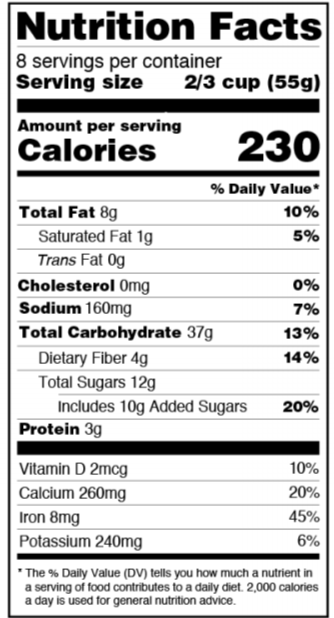Key points
- The Nutrition Facts Label on packaged foods is based on dietary recommendations for Americans.
- Read the label on your packaged food and drinks to track sugars, fats, protein, and other nutrients.
- Using the label can help you choose foods for a healthy diet.

Overview
The Nutrition Facts Label on packaged foods is based on dietary recommendations for Americans. The U.S. Food and Drug Administration (FDA) regulates what goes on the Nutrition Facts Label. Below are explanations of parts of the label and some tips for using it to follow healthy eating patterns.

Serving size
The serving size reflects what people are likely to eat or drink. This is not necessarily the portion you should eat. For example, one serving size of ice cream is labeled as ⅔ cup. A 12–ounce or 20–ounce bottle of soda is labeled as one serving.
Be sure you know how many servings are in packaged food. For example, if you buy what looks like an individual sized chicken pie, check the Nutrition Facts Label. It might actually be two servings. with double the calories and sodium of a single serving.
Dual Column Labels
Some food and drink packages that contain more than one serving may have a dual column Nutrition Facts Label. In that case, one column on the Nutrition Facts Label may provide calorie and nutrition information for one serving. Another column may provide calorie and nutrition information for the whole package.
Calories and fat
Larger, darker letters make calories the easiest item to see.
When it comes to health outcomes, the type of fat you eat matters more than the overall amount of fat. The Nutrition Facts Label shows total fat in grams and percentages of calories from fat.
The Nutrition Facts Label has separate lines for saturated and trans fats, which are less healthy than other types of fat. Look for foods with very little saturated and trans fats.
Sodium
The recommended daily limit for sodium is 2,300 milligrams. The Nutrition Facts Label indicates the number of milligrams of sodium in a serving.
Most sodium we consume is from salt, which is a common ingredient in processed foods. Read the Nutrition Facts Labels and choose the product with less sodium.
Added Sugars
The Nutrition Facts Label shows the percentage of calories from added sugars. Naturally occurring sugars, such as those in fruit or milk, are not added sugars. Added sugars include sugars that are added during the processing of foods. These include brown sugar, maple sugar, corn sweetener, corn syrup, honey, malt syrup, and molasses.
The two main sources of added sugars in the United States are sugary drinks and desserts/sweet snacks. Keep your intake of added sugars to less than 10% of your total daily calories. That means if you consume 2,000 calories in a day, added sugars should account for no more than 200 calories.
If you eat even one large dessert or sugary drink per day, you are likely getting more than the recommended daily limit of added sugar. Try drinking plain water instead of sugary drinks and limiting the serving size of treats. See how to Rethink Your Drink and Be Sugar Smart.
Nutrients
The amount of these nutrients are required to be on the Nutrition Facts Label:
- Vitamin D
- Calcium
- Iron
- Potassium
Food producers can voluntarily include vitamins A and C.
